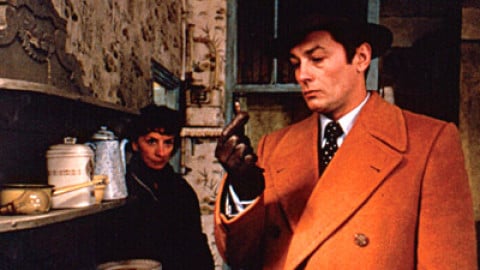
A Tale of Two Cities
Metropolis splits its heroine, Brigitte Helm’s iconic Maria, into two figures. One is a preacher of love who seeks to reconcile the ruling and the working classes. The other is a wanton robot on a mission of destruction. And just as there are two Marias, so there have long been two Metropolises. One is a mummified classic, hollowed out from endless recycling in film histories and in pop culture. The other is a Fritz Lang film with all the director’s visual complexity and drive (wedded to a Thea von Harbou script that, if it’s kitsch, is kitsch that soars).

For years now the false Metropolis has been running amok, courting charges of proto-Nazism, furnishing video backdrops for nightclubs, and fueling predictable academic studies (put a cyborg in a futuristic city as seen from Weimar Germany and you have the Ph.D. motherlode). The Lang film had been mutilated in so many ways that its creator insisted that it had ceased to exist. But it turns out that Lang’s Metropolis survived after all, locked away all this time (as the true Maria is locked up for part of the film). With the new restoration that premiered at the Berlin International Film Festival in February and that will come out on DVD later this year after a rep-house tour, Lang’s work has finally re-emerged: in many respects a new film, neither smothered by overfamiliarity nor butchered by cutting.
Metropolis fell under re-editors’ scissors soon after its 1927 premiere, to be distributed in assorted truncations and, later, reconstructions (the longest of which, that of 2001, was still missing about a quarter of the film). In 2008, film historian Fernando Martín Peña and museum curator Paula Félix-Didier identified a nearly complete print that had languished for decades, unrecognized for what it was, in a Buenos Aires archive. (For Peña’s account of the discovery, see issue #6 of Undercurrent) This print provided material for the new restoration, which was done by the Friedrich-Wilhelm-Murnau-Stiftung. The restored version improves on the old abridged ones in two main ways: it increases the visual and rhythmic density of the film through the addition of content; and it clarifies the correlation of images, characters, and plotlines through the completion of form.

The new restored content appears throughout the film but mainly involves these parts:
- The misadventures of Georgy (Erwin Biswanger), a worker at the underground machines that keep the city running
- Scenes of Joh Fredersen (Alfred Abel), the master of Metropolis, and Rotwang (Rudolf Klein-Rogge), a scientist, at a monument to a woman named Hel, whom both men loved
- The efforts of the sinister Thin Man (Fritz Rasp) to track down Fredersen’s son, Freder (Gustav Fröhlich)
- Freder’s comradeship with his father’s dismissed secretary, Josaphat (Theodor Loos)
- Several action episodes, notably one in which the robot Maria incites a mob of discontented workers to attack the critical Heart Machine, and one in which Freder and Josaphat, rescuing the workers’ children from the ensuing flood, climb up an air shaft and break through a gate at the top.
Three characters who were blurry in previous editions of Metropolis—Georgy, the Thin Man, and Josaphat—now come into focus. Georgy, whom Freder replaces at the labor-cum-torture of moving the clocklike arms of a large dial, emerges as Freder’s opposite number: while love for Maria redeems Freder from a life of empty hedonism, Georgy falls easy prey to the temptations of Yoshiwara, the Metropolis sin-pit where the robot Maria will make her debut. Formerly a striking but puzzling presence, the Thin Man is now a full-fledged character, satanically enjoying the cat-and-mouse harassment he inflicts on others. Josaphat, who gets a boost in stature from the restored material (as does Freder himself, formerly the most nominal of nominal heroes), develops into an engaging co-hero.
Older versions were plotbound, so that for all its vast scale the film seemed constrained. Only with the Argentine footage does Metropolis breathe freely, encompassing the places and rhythms of everyday life. A delightful restored shot features the Thin Man standing at a newsstand, keeping baleful watch on Georgy from behind an unfolded Metropolis Courier. Bit players ride in open elevator cars that slowly ascend and descend in the background of a scene between Josaphat and the Thin Man, reminding the viewer how rare it is, in this film filled with purposeful crowds, to see people who play no part in the plot. In an interlude of respite at Josaphat’s apartment, Freder’s relaxed air of well-being discloses a native confidence that makes him a more appealing and convincing hero than he was in past versions.

Although Metropolis has long been regarded as a parable about capitalism, only with the new restoration do we actually see money—when the Thin Man tries to bribe Josaphat. The sheafs of currency he hauls out from his coat link visually to the Yoshiwara handbills that tumble down over Georgy (in another restored scene), which in turn are doubles of the mysterious maps that Fredersen’s men find in workers’ pockets.
The restoration of the Hel monument scenes (cut, supposedly, because the preparers of the American version objected to the woman’s name) adds a crucial level—the top one—to the film’s vertical hierarchy. Looming over Rotwang and Fredersen, Hel’s giant stone head embodies an abstract destiny that enfolds the entire city. (Hel herself prefigures the lost women who motivate a series of vengeful protagonists in Lang films, and Rotwang’s surrogate repossession of Hel through the robot he invents marks Metropolis as one of multiple Langian intersections of desire and dehumanization.) As Lang intercuts the mob of workers hunting for the “witch” Maria with the robot leading a band of revelers in the streets, a magisterial cutaway finds Rotwang walking alone toward the Hel head, as if the whole parallel-action cataclysm were his tribute to her.
New footage also expands and elevates the final section, putting greater emphasis on the endangered children, the heroes, and the emotional mothers (who link Metropolis to the 1931 M). At the 2,000-seat, sold-out Friedrichstadtpalast premiere in February, the final reconciliation between “Hands” (a laborer) and “Head” (Fredersen) by means of “Heart” (Freder) seemed to come off for the first time in my experience of Metropolis. It’s hard to tell, however, how much this achievement owed to the cumulative power of the restored footage and how much to the Rundfunk-Sinfonieorchester Berlin’s live performance of Gottfried Huppertz’s full-blooded original score.

Lang’s structure—as elaborate and ambitious as in his Mabuse films—is now clear. The same can’t, without qualification, be said of the footage from the Argentine print, a 16mm dupe defaced by a blizzard of scratches (the other materials of the restoration are in better shape: watching the whole is like reading a book with a fourth of the text printed in red). Still, for the first time since 1927, Metropolis exists. In 1985, Enno Patalas (whose archival work laid the groundwork for all reconstructions of the film) wrote, “Metropolis has been thoroughly and irreparably destroyed, as few other films have been.” Strike “irreparably.”







